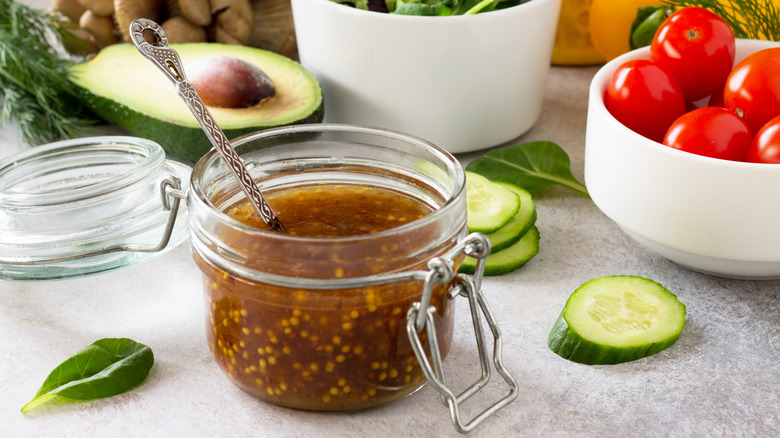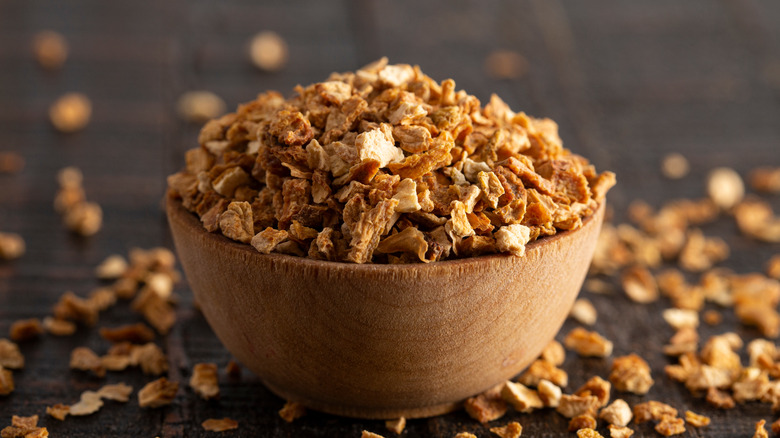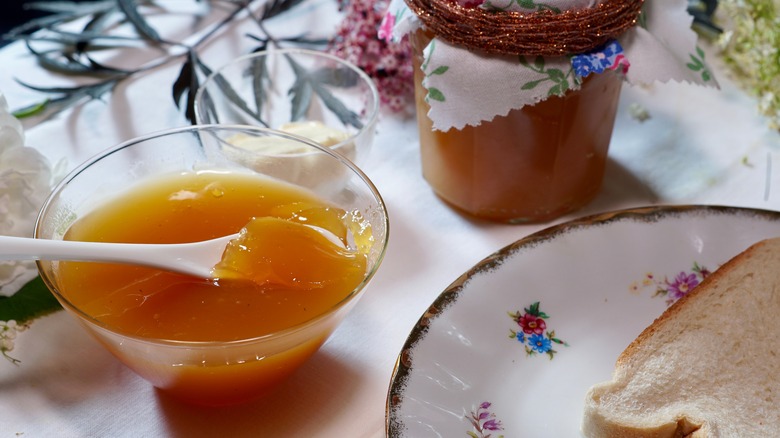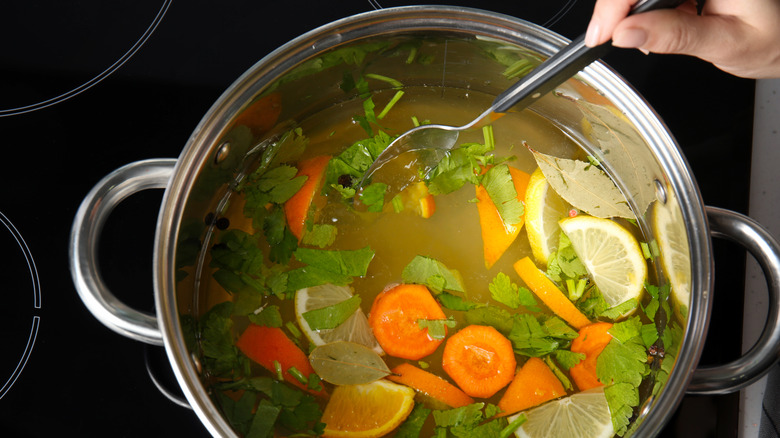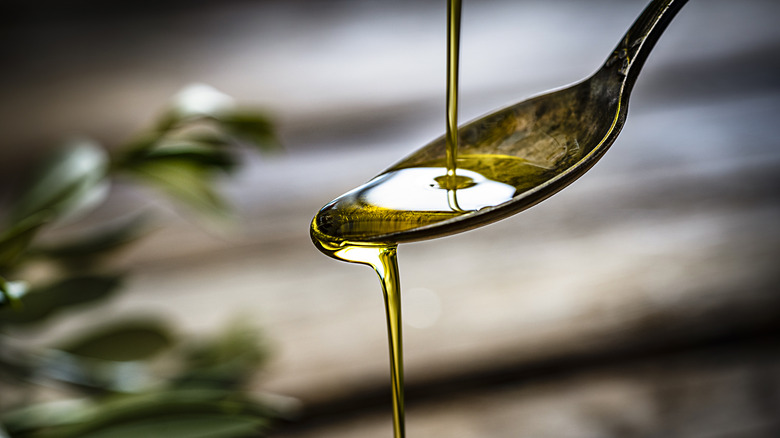11 Ways To Use Leftover Grapefruit Peels
The saying "one man's trash is another man's treasure" holds true when it comes to cooking with fruit and vegetables. Many parts of produce that are considered scraps are actually nutritious and delicious ingredients — if you know how to prepare them. Learning to cook with things you usually throw away is an excellent way to reduce waste and spend less money. Plus, it is fun, as it encourages you to be creative with your cooking and to look at produce differently.
Grapefruit peel provides a perfect example of a fruit part often overlooked despite being tasty and good for health. Rich in vitamins, minerals, and antioxidants, grapefruit peels are packed with health benefits. They contain high levels of vitamin C, which helps boost your immune system and give your hair and skin a healthy glow. Additionally, grapefruit peels are high in dietary fiber, which is good for digestion. The essential oils found in the peel, such as flavonoids, have anti-inflammatory and antioxidant properties, which studies suggest reduce the risk of chronic diseases — and some even show promise for fighting some forms of cancer.
Beyond their health advantages, grapefruit peels contribute a unique and vibrant flavor profile. They provide a tangy, slightly bitter twist to many dishes and beverages. If the health benefits haven't convinced you to start cooking with grapefruit peels, this list of cocktails, candies, and condiments will.
Add grapefruit peel to vinaigrettes and condiments
Grapefruit is the overlooked sibling of the citrus family, which is a shame because its flavors strike the perfect balance between lemons and oranges. While lemon peel is sharper and orange peel is sweeter, grapefruit peel provides a blend of bitterness and tartness. This makes it a great addition to homemade salad dressings and sauces.
To use grapefruit peel in your vinaigrettes and condiments, simply zest your fruit directly into your mixture. The key to successful zesting is to remove as much of the colorful outer layer as you can while avoiding the white pith beneath. Cut your fruit in two so that you can lay it on its flat side, providing a more stable surface. Use a paring knife, a fine grater, or try a microplane, working slowly so as to avoid the pith.
Grapefruit zest works particularly well in vinaigrette salad dressings, as the tanginess complements the vinegar's acidity and the olive oil's richness. Add a tablespoon of zest and, if you have it, ¼ cup of grapefruit juice to your standard recipe. Grapefruit flavors also go well with creamy and herby sauces, making it a versatile ingredient. Adding it to your go-to flavors is a sure-fire way to make your condiments and sauces stand out.
Sprinkle grapefruit peel zest over seafood for a fresh zing
In food traditions around the world, citrus and seafood have found each other. They have undeniable chemistry — literally, in some cases. When you add lemon to ceviche, the citrus acid denatures the proteins of the fish, turning it firm and opaque. For other types of seafood, citrus brightens the flavors and provides a refreshing contrast to the oily textures. It also helps neutralize the brinier or "fishier" flavors. This makes grapefruit peel zest an excellent addition to seafood dishes, as it provides a uniquely tangy and slightly bitter flavor.
Use a paring knife, a microplane, or a grater to zest your grapefruit, carefully avoiding the white pith. Be sure to taste a small part of the zest before adding it to your dish, as each grapefruit can vary in bitterness and sweetness. If the zest is too bitter, you can reduce the quantity to ensure it complements rather than overpowers the seafood. Sprinkle the zest over grilled, baked, or pan-seared fish just before serving. For shellfish, such as shrimp or scallops, toss them with the zest after cooking to preserve the most vibrant, punchy, citrus flavors.
Make candied grapefruit peel
Candied grapefruit peel has a delightful combination of sweet and bitter flavors, which are a good match for the bittersweet nostalgia it invokes. Traditionally eaten at Christmas time, the candied peel is easy to make and can be eaten on its own or added to sweet and savory dishes.
To prepare candied grapefruit peel, start by thoroughly washing the grapefruit and peeling it in long strips. Remove as much of the white pith as possible to reduce bitterness. Place the peel in a pot and cover with cold water. Bring to a boil and let it simmer for five minutes, then repeat this step. This softens the peels, giving them a pleasant chewy texture. Next, simmer the peels in a simple syrup made from equal parts sugar and water until they become translucent and tender, which takes about 30 to 45 minutes. Once cooked, remove the peels from the syrup and let them dry on a wire rack. For an extra touch, roll the dried peels in granulated sugar or dip them in chocolate.
Candied grapefruit peel can be enjoyed as a snack or chopped and added to baked goods like cookies, cakes, and muffins. It can also be used as a garnish for cocktails or added to salads or savory dishes for a hint of sweetness and citrus flavor. Candied citrus peel stores well — you can keep it for six to eight weeks in a cool, dry place.
Spritz or garnish a cocktail
What do Mr Potato Head and a cocktail have in common? Quite a lot, according to an expert bartender named Phil Ward. Ward's approach is simply that you can mix, mingle, and replace the elements of a cocktail in many funny and intriguing ways — just like you can rebuild that toy spud's face in an array of quirky combinations.
One great example of a Mr Potato Head cocktail is to replace gin and orange peel in a negroni for tequila and grapefruit peel. You can play around with grapefruit in many other cocktails, too. Just replace lemon with grapefruit, and let your taste buds discover new and interesting concoctions. Use grapefruit peel to garnish a cocktail and add a pinch of flavor, or learn to spritz — a unique way of torching peel that looks really cool and scatters droplets of citrus into your drink, impressing both yourself and your friends.
Make an all-purpose cleaner
Grapefruit peels can be useful both for cooking and for cleaning up afterward. You can create an all-purpose cleaner with grapefruit peel and white vinegar, which helps reduce waste and use fewer chemicals in your home. Vinegar's acidic properties make it a powerful cleaning agent, capable of cutting through grime and even killing bacteria. Grapefruit peel also has antibacterial effects, plus it adds a fresh, citrus scent to the mixture, making it more pleasant to use and leaving your home smelling fresh.
To make the cleaner, wash and peel your grapefruit, and remove as much of the white pith as possible. While its bitter taste won't be a problem, it can make the cleaner sticky. Place the peels in a jar and cover them with white vinegar until fully submerged. Seal the jar tightly and leave it for about 10 days. The vinegar will extract the natural oils from the grapefruit peels, releasing their cleaning properties and a refreshing citrusy smell.
After the mixture has infused, strain out the peels and pour the infused vinegar into a clean spray bottle. Shake the bottle well before each use to ensure the ingredients are well mixed, then simply spray onto the surface you want to clean. For tougher cleaning jobs, such as dirty floors or mildewy showers, you may want to add a tablespoon of Borax or bleach to the solution. If you store this cleaner in a cool, dark place, it will keep for several months.
Dehydrate grapefruit peels to flavor drinks and food
If you have a large quantity of leftover grapefruit peels, you might not want to use it all right away. Drying out the peel preserves its vibrant flavor and lasts longer than fresh zest. Making dehydrated grapefruit peels is surprisingly simple and doesn't require any complicated equipment. Start by cutting your grapefruit peel into similar-sized strips using a sharp knife or vegetable peeler, making sure to avoid the white pith, which can be overwhelmingly bitter. Lay the strips cut-side up on a baking tray and dry them out at a low temperature in the oven — 170 F to 200 F — for about half an hour. Alternatively, you can allow them to dry on your countertop over two or three days. When ready, the peels should curl and harden slightly.
You can use dehydrated peel in the same way you would use zest. Add it to cocktails or sauces for a citrusy twist, or sprinkle it on savory dishes. Alternatively, you can grind your dried grapefruit peels into a powder and use it as a seasoning in your cooking, similar to how dried tangerine peels are used in traditional Chinese dishes like orange beef or chicken.
Store your dehydrated grapefruit peels in an airtight container in a cool, dry place. This helps keep them flavor-filled and ready to add a citrus twist to your drinks and dinners.
Make your own grapefruit marmalade
Another great way to prepare peels for later use is to make grapefruit marmalade. This chunky, citrusy preserve is ideal for spreading on toast, baking, or even as a glaze for meats. The sharpness of grapefruit cuts through the sugariness of marmalade, creating a tangy-sweet flavor that any citrus fan will love.
Making marmalade is a two-day process, but it is worth it. Wash your grapefruits and finely slice them with the peel, removing any seeds. Place your fruit in a pot, add enough water to cover them, and let it soak overnight. This helps the peels to soften and also releases the pectin that will help your marmalade set without the need for gelatin. The next day, bring the fruit and water to a boil and let it simmer for around half an hour or until the peels are soft. Then add the same quantity of sugar as you have fruit, stir it in, and bring it back to the boil. Let it simmer, stirring frequently, until the marmalade thickens. This should take around 20 to 30 minutes. To test whether it is done, place a small spoonful on a chilled plate. It should set and wrinkle slightly when poked with a finger.
Let your marmalade cool slightly before pouring it into sterilized jars. Seal them while the mixture is still warm, as it helps the jars seal tighter and store for longer.
Infuse vodka or tequila with grapefruit
Infusing spirits at home is easier than you might think, and it allows you to make lower-end bottles taste like they come from the top shelf. Vodka and tequila both go well with citrus, so grab a bottle and some grapefruit peels, and you are ready to go.
Like other recipes on this list, you should begin by thoroughly washing your peel and removing the white pith. Slice the peel into strips and place it in a clean jar or bottle. Pour in the vodka or tequila, ensuring the grapefruit is fully submerged. For the peel of one large grapefruit, you'll need around 3 cups of vodka or tequila. Seal the jar tightly and store it in a cool, dark place. Allow the mixture to infuse for three to seven days, shaking the jar gently once a day to mix the flavors. Taste it every so often, and once it reaches your desired strength and flavor, strain the liquid through a fine mesh sieve or cheesecloth to remove the grapefruit peels and any pulp. Transfer the infused vodka or tequila back into its original bottle or another clean bottle for storage.
Drink your grapefruit-infused vodka or tequila on its own, or use it in cocktails. It works wonderfully in classics like margaritas, Palomas, or a simple vodka soda with a slice of fresh grapefruit on the side. Store the infused spirit in a cool, dark place, where it will keep for several months.
Prepare grapefruit brine for flavoring your meats
One of the most important things to consider when cooking meat is how to keep it moist and tender and keep all the flavorful juices inside, and brining is a tried-and-tested way of doing this. Soaking meat in heavily salted, seasoned water denatures the meat's proteins, which partially unravel and transform the texture of the meat. It becomes more tender and holds onto moisture better. Plus, it means every bite of your meat will be seasoned and salted.
Citrus flavors, including grapefruit, are a welcome addition to a brine. You can add both the juice and the zest to ensure an acidic, fruity zing to your meats. To prepare a grapefruit brine, start with a basic brine solution. In a large pot, combine 1 gallon of water with 1 cup of kosher salt and ½ cup of sugar. Heat the mixture over medium heat, stirring until the salt and sugar are completely dissolved. Remove from heat and let it cool to room temperature. While the brine cools, zest two grapefruits, avoiding the white pith to prevent bitterness. You can also add the grapefruit flesh, cut into wedges, for added flavor.
Cover your meat with the grapefruit brine, and leave it in the fridge for four to six hours for chicken, six to eight hours for pork, and up to 24 hours for larger cuts of meat. Drain the brine, rinse the meat in cold water, and then cook your moist and subtly flavored meat.
Infuse oil with grapefruit peel to use in cooking
If you have flavored oils in your pantry, you can add a few drops to make weeknight dinners a little more special. So why not make a citrusy-infused oil with your leftover grapefruit peels?
Wash and peel your grapefruit, removing the white pith. Cut them into small pieces and place them in a saucepan with your oil of choice — the best are oils with a high smoke point, such as extra virgin olive oil or canola oil. You should use the peel of one large grapefruit for every cup of oil. Heat the oil and grapefruit peel over low heat, allowing it to warm gently. Avoid boiling the oil, as high heat can degrade the oil and the citrus flavor. Maintain a low simmer for about 10 to 15 minutes, then remove the saucepan from the heat. Let the mixture cool to room temperature, allowing the flavors to settle and meld together.
Once cooled, strain the oil through a fine mesh sieve or cheesecloth to remove the grapefruit peel. Pour the infused oil into a clean, airtight bottle or jar for storage. Store the grapefruit-infused oil in a cool, dark place, where it will keep for up to two weeks. For longer storage, you can keep the oil in the fridge, but bring it to room temperature before use to ensure the best flavor and consistency. Drizzle it over salads, roasted vegetables, or grilled meats for a burst of citrus flavor.
Brew some grapefruit peel tea
For many people, preparing and drinking tea is more than just a beverage; it is a ritual. Different moods require different flavors, from calming chamomile at night to strong English breakfast tea in the morning. Fruit flavors work all day long, including grapefruit, and you can make an excellent grapefruit tea from fresh or dried-out grapefruit peels. It's a great way to enjoy citrusy flavors, as well as all the health benefits of grapefruit peel.
For a cup of tea, take a tablespoon of fresh or dried grapefruit peel and place it in a teapot or a heatproof mug. Pour boiling water over the peels and let them steep for about 10 minutes. For a stronger flavor, you can let the tea brew longer. If you'd like, you can add other ingredients like a slice of fresh ginger, a cinnamon stick, or a few cloves. Experiment with different combinations and find which is your favorite. Strain the tea before drinking, and add sweeteners to taste. If you'd like to drink it cold, let the tea cool, then refrigerate, and serve over ice with a slice of fresh grapefruit. The result is a fragrant, slightly bitter tea with a bright citrus flavor.

